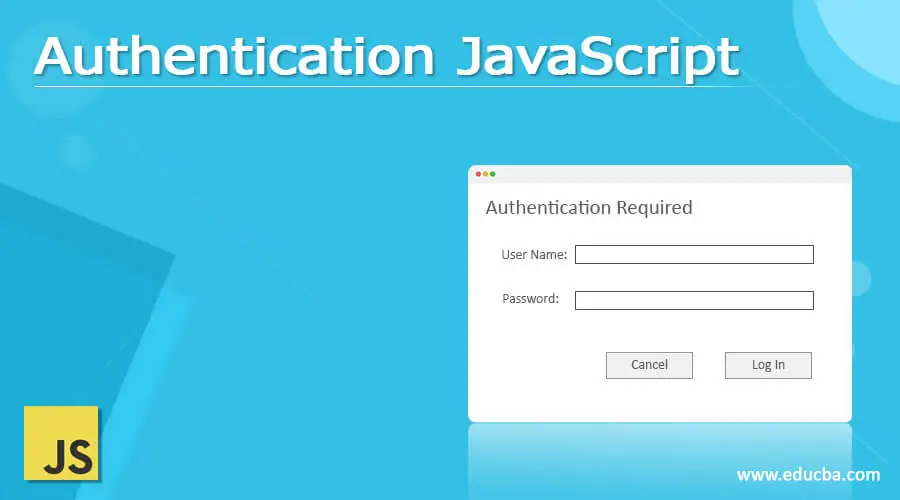
Introduction to Authentication JavaScript
Authentication JavaScript is nothing but JavaScript using the client ID to obtain Google ID token through Google Auth 2.0 server and then sending this generated token in request calls. Then the endpoint framework use client ID for authenticating the token ID that the JavaScript application has sent. Authentication, as the word means, it is the process of recognizing one’s identity in general. Coming to technical language, it is a mechanism of associating incoming requests with a set of identifying user credentials. Authentication helps in confirming the server to get to know who is the user accessing the website. Here, we shall see how Authentication in JavaScript works, Types of Authentication, and various ways in which Authentication can be implemented using JavaScript or any other means.
How an authenticated request is run from JavaScript application?
Prerequisites for having a JavaScript application with Authentication:
1. User must deploy API with endpoint framework in Java and to make sure user gets a successful response.
2. User needs to find the Google Cloud ID that is created for sample API, which needs to be added to JavaScript code.
3. User needs to have a web server on the local computer to serve HTML file containing JavaScript code.
4. To setup Authentication, the user needs to configure OAuth 2.0 ID in JavaScript and the backend code.
5. JavaScript application uses client ID to obtain the Google ID token from OAuth 2.0 server and send ID in the request.
6. Endpoint framework will use client ID to authenticate the ID token that the application has sent in the request.
Authentication runs at starting of the application, before permissions and checks occur, also before other code is allowed to proceed.
Different systems require different type of user credentials to ascertain one’s identity. Credentials often have a form of password, that is a secret value and is known to individuals and systems.
There are 3 categories in which a user can be authenticated,
1. Something user knows
2. Something user is
3. Something user has
Generally, Authentication can be in two phases: Identification, and Actual phase of Authentication.
Identification: This phase provides user’s identity to the security system; it is in the form of the user ID. Security system will search for all abstract objects that are known and find the correct one for which user is applying. With this, user will be identified but what the user claims does not mean to be true as the actual user can be mapped to other abstract users. Hence user must provide some evidence to provide his/ her identity.
Actual phase of Authentication: Process of determining claimed identity of the user by verifying user-provided evidence is Authentication and the evidence provided by the user for authentication is known as credentials.
Top Libraries used for Authentication in JavaScript
1. Passport JS
It is not just a 15k user authentication library but is the most common for JS developers to use this external library for user authentication. This library will provide relatively flexible and middleware for NodeJS applications that can be integrated into any of the ExpressJS based web applications. It is also a community platform that supports various other common authentications like username and password.
2. AuthO
It is not a JS library but a service. AuthO is a start-up company that provides wide universal authentication and an authorization platform for mobiles, web, and legacy applications. There are almost 100+ pre-built integrations with AuthO.
3. Permit
As with Passport JS, there were a lot of issues that make the codebase complicated, and hence came Permit, a library that makes it easy for adding an authentication layer to any API. It can be used with any of the popular server frameworks like Express JS, Koa, Fastify, Hapi and can be used with API types like REST, GraphQL, etc. Permit will let user authenticate via two ways, a single secret bearer token or a set of username and password credentials.
4. Grant
Grant is a new and promising JS library that provides OAuth Middleware for Koa, Hapi, Express with almost 180 supported providers and live playground. In cases, where user wants to use with own private OAuth provider, user can provide required key.
5. Feathers Authentication Management
Feathers is an open-source real-time micro-service web framework for NodeJS applications that gives control over the data via RESTful resources, flexible plugins, and sockets. It also provides authentication and management modules that let users add for sign-up verification, forgot password reset, and various other capabilities to feathers authentication. Idea of this is to combine different authentication methods in a flexible infrastructure.
6. Just use Firebase Authentication
This is not a long-term solution for managing user authentication but only for small applications. It is useful in getting the work done quickly in a simple manner for all applications deployed using Firebase. It provides backend services, easy-to-use SDKs, and ready-made libraries to authenticate users to applications. It also supports authentication using phone numbers, passwords, etc.
Conclusion
With this, we shall conclude the topic “Authentication JavaScript”. We have seen what Authentication JavaScript means and how is it implemented using OAuth 2.0. We have also seen the two phases of authentication i.e., Identification and the Actual phase of Authentication. There are also types of Authentication Libraries in JavaScript, out of which some of the top libraries are listed above. Based on the understanding, one can easily choose which type of authentication library would be helpful for their applications. Thanks! Happy Learning!!

